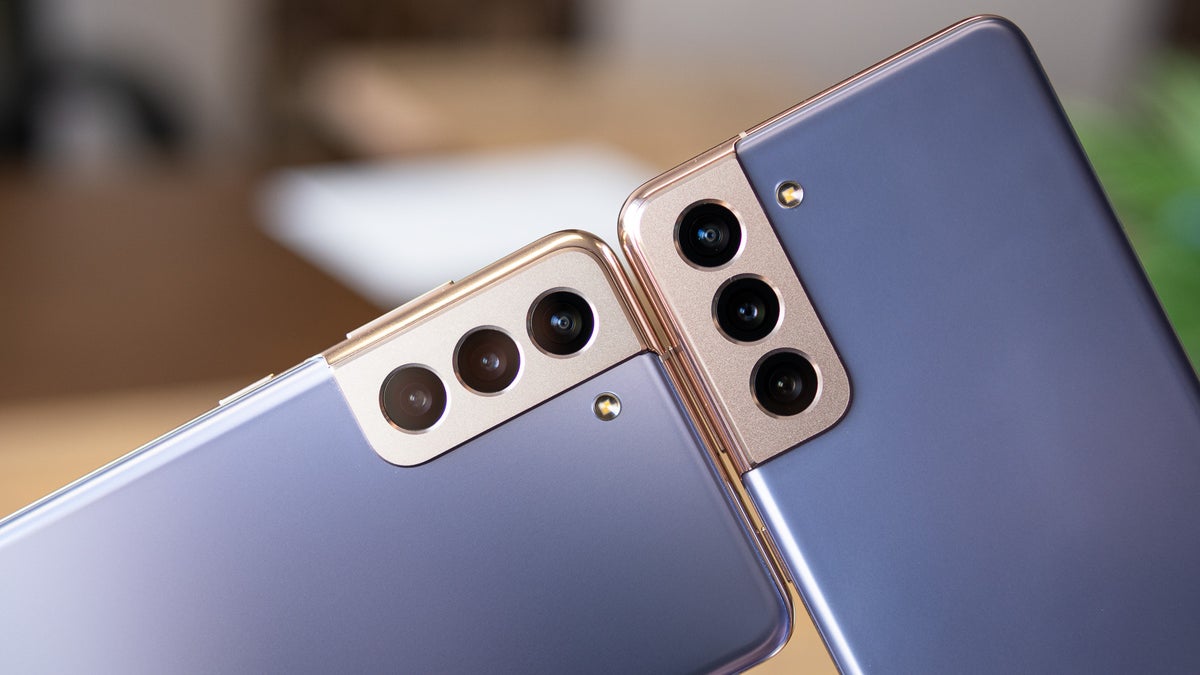Samsung Galaxy S21 vs Galaxy S21 Plus
We may earn a commission if you make a purchase from the links on this page.

Unlike with the S20 series, Samsung has put more distinction between the S21 models this time around, what with the the cheaper members of the clan sporting 1080p flat displays and largely untouched camera sets compared to their predecessors. This gives the S21 and S21+ a boost compared to their predecessors in the all-important price direction.
What about the differences between the two phones themselves, though? After comparing the larger set - Galaxy S21+ vs Galaxy S21 Ultra - we are now gearing up to compare the Galaxy S21 and S21+ and help you decide which one to pick during that preorder S21 deals window.
Samsung Galaxy S21 vs Galaxy S21+ price, colors, and storage
- $799 (128GB) vs $999 (128GB)
- Grey vs Black
- White vs Silver
- Violet
- Red and Pink Galaxy S21+ exclusively at Samsung
Samsung nixed the curved 1440p display panels of the S20 and S20+, and replaced them with flat 1080p ones for the S21 and S21+, and we may be all the better for it, as the lower panels resolution should offer improved battery life, and they would cater to the "never-curved" crowd. The downsides are a bit more width in comparison with their S20 series predecessors, and a tad thicker bezel, as Samsung shaved off the chin of the S21 and S21+, but spread the remaining width around the frame to make the phones look more symmetrical at the front.
With lesser display specs come lesser Galaxy S21 and S21+ prices, compared to the S20 and S20+ launch tags. In fact, from a pricing standpoint the fight would rather be between the S21 and the iPhone 12, and S21+ vs 12 Pro, for instance, rather than the Max, since they start from the same base price position.
The stylish new Contour Cut design that blends the camera island on the back with the side frame comes in new colors, too. The Galaxy S21 is arriving in four colors at launch - gray, pink, violet and white, while the S21+ lands in black, as well as silver and violet, or an exclusive pink and red S21+ over at Samsung.
You might also like:
Samsung Galaxy S21 vs Galaxy S21+ display size and specs
- 6.2" FHD+ vs 6.7" FHD+ dynamic 120Hz refresh flat displays
- 5nm Snapdragon 888/Exynos 2100
- Integrated 5G modems
- 8GB RAM, 128GB/256GB storage
The 6.2"display size of the Galaxy S21 is way smaller than the 6.7" panel of the S21+ which makes the middle child only slightly smaller than the S21 Ultra. As we mentioned, the phones are a tad wider this time around, but thanks to the tall aspect ratio still bearable for one-handed usage, especially the S21 which could very well be called a compact phone in this day and age. Moreover, Samsung offers more screen real estate, as there is no unsightly notch at the top, just the front camera opening pierced into the screen in a so-called Infinity-O design.
While the screens of the S21 and S21+ have lower resolution than on their predecessors, they compensate by exceeding in the more important metrics - refresh rate, brightness, and color represenation. The S21+ colors run a tad colder but the display is brighter, and both phones cover the wide color gamut very well.
Not only are the screens much brighter than before, with the S21+ taking the lead, but they also offer much more granular 48Hz-120Hz variable refresh rate. While the screens on the S20 and S20+ stayed at 120Hz no matter what's on, the S21 and S21+ run at the minimum while you are watching 30fps YouTube videos, for instance, and rev up to 120Hz while you play Minecraft, or browse and scroll. What's more, the process is now fully automated, and you don't have to manually change anything.
As for advantages under the hood, Galaxy S21 is powered by the newest Snapdragon 888 in the US which may not beat Apple's A14 in raw benchmarks, but has the exciting advantage to ship with a fully integrated 5G modem, as opposed to Apple's tack-on modular solution that is a battery hog. Consequently, Qualcomm boasts up to three times performance per watt improvement when compared to the Snapdragon 865 in the S20.
The 888 chip features the Kryo 680 CPU which Qualcomm says is 25 percent more powerful and 25 percent more power-efficient than the previous generation. The primary core is based on Arm's Cortex-X1 design, just like Samsung's other S21/S21+ chipset, the Exynos 2100.
While the Galaxy S21 vs S21+ Snapdragon 888 benchmark scores comparison exhibit a tad better performance compared to the Exynos 2100 models, they are also carried out at the 1.8Ghz speed of the slower cores, so the Snapdragon variant that the US got seems again to one-up the Exynos models. The real-world performance, however, is without precedence in the Android land on both versions.
Looking at CPU benchmarks, we notice there isn't much of a difference in terms of performance, just as you would expect from two phones powered by the same SoC. So that's why it's more interesting to look next up, at...
Sustained Gaming performance
This is where things get interesting. The Galaxy S21 being a much smaller phone is obviously limited in terms of heat dissipation and this shows very clearly in this test. Just after 4 minutes of running this gaming benchmark, we notice the small S21 throttle and lose more than 35% in performance. That is a dramatic drop! The S21 Plus, on the other hand, takes double that time to reach its throttling threshold. It only slows down after running 8 minutes of this gaming benchmark, but once again, the drop is similarly steep as on the smaller S21.
So yes, we definitely see the Exynos chip that powers both these phones has a hard-coded limit that it reaches after heating up, but the larger footprint of the S21 Plus allows it to run the phone at max capacity for much longer and that is definitely a big plus for gaming.
Samsung Galaxy S21 vs Galaxy S21+ battery life and charging speeds
- 4000mAh vs 4800 mAh
- 25W/30W/45W wired charging
- 15W wireless charging
The battery unit of the S21 is actually similar to the 4000mAh EB-BG980ABY piece that is found inside the S20 as well, so battery life should have been about the same, right? Well, not really.
The FHD+ (S21) vs QHD+ (S20) display
While the Galaxy S20 is equipped with an overkill 1440p resolution on a comparatively tall and narrow 6.2" screen, Samsung went the smarter route this time around, and is launching the S21 with a 1080p panel. The lower pixel density makes for a much more frugal panel, as there are 1MM+ less pixels to light up and manage with the graphics subsystem. Our own battery tests show that phones with FHD screens perform 20-30% better in terms of battery life than those with QHD or higher screen resolutions when we average out for the battery capacity difference.
Tap the lower band of that range, and the S21 should outlast the S20 with two hours, hitting a tenner in our browsing and scrolling battery test, all other things being equal. The point is they won't be equal, however.
The 5nm (S21) vs 7nm (S20) processor
Compared to the second-gen 7nm (7LPP) Snapdragon 865 processor in the S20, made in the TSMC foundry, the 5nm Snapdragon 888 is made using Samsung's new EUV process. The fact that Qualcomm not only switched nodes from 7nm to 5nm, but also the foundry itself , is a vote of confidence in Samsung's Extreme UltraViolet (EUV) lithography.
According to Samsung, its 5nm EUV process offers not only a fifth smaller footprint of the chipset at the same performance, but also about 20% smaller power draw. Alternatively, phone makers can choose to gain a 10% performance increase at the same battery consumption. Given that mobile chipsets are already powerful enough for anything you may throw at them, and the new X1 cores are clocked at the same 2.84GHz as the 865, Samsung is likely to go with the generous power consumption decrease.
The integrated (S21) vs standalone (S20) 5G connectivity
The 7nm vs 5nm process alone won't make a significant extra difference in battery life between the two phones, though, as the main power draw comes from the display. The phones' 5G connectivity battery draw, however, will, as maintaining a link to the 5G network is a battery hog. Why? Well, first off, before Snapdragon 888, only Huawei had integrated 5G system-on-a-chip (SoC) for flagship phones. Qualcomm made do with chipsets like the 765 in the Pixel 5 or LG Velvet, which, albeit having the 5G modem as an integral part of the chipset, are a far cry from its 8-series in terms of performance.
With Snapdragon 888, however, Qualcomm managed to finally do what it does best - pair the fastest ARM Cortex cores available with a new powerful Adreno 650 graphics AND fuse them with the X60 5G modem that is also made on the 5nm process. That alone amounts for a significant drop in power consumption when connected to a cell tower but Korean media just reported that there will also be improvements in the 5G antenna hardware.
Next-gen 5G antenna isolation
Fast 5G networks like Verizon's Ultrawide Band (UWB) mmWave can carry a lot of data at once and fast, but have very bad signal penetration that forces phone makers to slap a bunch of extra antennas all around their handsets just so that the signal can pass through your grip alone.
The Elec, however, is reporting that Samsung will use the next generation of low permittivity polyimide (PI) films for the 5G antennas in the Galaxy S21 phones. This means easier signal passthrough, and less toll on the battery. Taken individually, all these power draw improvements, with the exception of the lower pixel density, may not amount to much, but as a whole, should provide a healthy boost to the Galaxy S21 battery life from the same 4000mAh battery capacity.
Galaxy S21+ battery life improvements over the S20+
- 4800mAh battery vs 4500mAh in S20+
- 1080p display vs 1440p on the S20+
- Frugal 5nm chipset with integrated 5G modem vs 7nm and standalone on S21+
- Next-gen 5G antenna isolation film
For the 6.7" Galaxy S21+, Samsung went a slightly different route, perhaps because the S20+ sales were a surprise hit at launch. Not only will it ship with an FHD instead of QHD display resolution, too, just like the S21, but Samsung is using the larger body to also fit a larger battery compared to its predecessor.

The 4800mAh battery of the S21+ is bigger than the S20+ piec
Just 200mAh short of the giant 5000mAh battery in the S20 Ultra, the S21+ pack could catapult it to the top of the Galaxy S21 series battery life pile, as all other energy-saving components - 5nm chipset, integrated 5G modem and better antenna isolation - also apply to the S21+ as well.
On the whole, the Galaxy S21+ delivers better battery life than the S21. The larger screen area is offset by a much larger battery, and, with 1080p resolution in tow, it beats the munchkin's stamina, especially in our browsing and scrolling test, so if endurance on a charge is what you are after, grab the biggies, as they both charge very fast but only one has a huge battery.
Samsung Galaxy S21 vs Galaxy S21+ cameras comparison
- 12 MP main sensors
- 64MP crop zoom cameras
- 12MP ultrawide-angle cameras
Unfortunately, when it comes to the Galaxy S21 and S21+ cameras, Samsung isn't changing much compared to the S20 and S20+, if we don't count the actual pretty camera island design that blends with the side frames of the upper right corner on the back.
Тhe Galaxy S21 and S21+, just like the S20 or S20+ before them, lack a periscope or telephoto zoom camera. They use a 64-megapixel secondary camera for the purpose, and Samsung itself admits that what it calls a "telephoto camera" actually sports a lens that is very much wide-angle, almost as wide as the lens on the main camera.
Contrast is slightly more overstated in comparison with the Galaxy S20+, but that's not necessarily a bad thing as it adds character to the pictures. Dynamic range is definitely better resolved on the Galaxy S21+ than on the Galaxy S20+. Despite the loss of a ToF sensor, the Galaxy S21+ is capable of capturing great portraits with very good subject separation and few if any artifacts, too.
Аll the zooming is actually almost entirely based on software - cropping and merging with the information from the main sensor. The end result, however, is good pictures and lower pricing compared to their predecessors, so we can't rant too much about the lack of a meaningful upgrade.
Where the new S21 and S21+ excel compared to their predecessors, and to a lot of other phones in general, is night shots. Samsung's Scene Optimizer now automatically enables Night Mode when it detects that the light is too dim, and in mhy experience, it would err on the side of caution and rather enable Night Mode than take a regular picture.
Selfies are lovely and very detailed, but the portrait feature of the front camera is prone to blurring out things it shouldn't, like sunglasses resting atop your head or other.
To sum it up, the Galaxy S21 and S21+ have identical camera hardware which hasn't really changed in a noteworthy detail from the kits on their predecessors. The image processing and software algorithms, however, have changed for the better, delivering great low-lights shots, and more stable zooming, while dynamic range capture has also been improved. Save for a couple of object separation issues with portrait shots, and the near-useless 30x zoom, the Galaxy S21 and S21+ cameras won't leave you disappointed.
Let's sum up the Galaxy S21+ vs Galaxy S21 advantages we found during the cours of this comparison:
- Better battery life
- Brighter display
- Glass vs Glasstic body
- More color options
- At a $200 higher price
Follow us on Google News







































Things that are NOT allowed:
To help keep our community safe and free from spam, we apply temporary limits to newly created accounts: